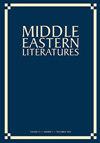Centering the black slave in Bahāʾ Ṭāhir’s Wāḥat al-ghurūb
IF 0.2
4区 文学
0 LITERATURE
引用次数: 0
Abstract
ABSTRACT This paper constructs the story of Niʿma, a Sudanese or Nubian slave in Bahāʾ Ṭāhir’s Wāḥat al-ghurūb (2006; Sunset Oasis 2009). Set in late nineteenth- and early twentieth-century Egypt, the novel revisits the 1881–1882 Urābī Revolution and the subsequent British invasion. Through the male protagonist, Maḥmūd ʿAbd al-Ẓāhir and his relationship with Niʿma, his concubine, Wāḥat al-ghurūb re-evaluates Egypt’s nationalist rhetoric. Made to represent an essence of Egypt, Niʿma is denied her history and memory except as an exotic, jasmine-scented Scheherazade whose folktales captivate Maḥmūd, and whose sexuality satiates him. I argue that despite the absence of her voice Niʿma shows agency mainly through casting herself as an active storyteller and additionally through her decisions to stay with her masters after their bankruptcy, and later to leave the house when she realizes that Maḥmūd sees her as a commodity.以巴哈古兰经Ṭāhir的Wāḥat al-ghurūb为中心的黑人奴隶
摘要:本文构建了《巴哈古兰经》Ṭāhir Wāḥat al-ghurūb (2006;日落绿洲2009)。故事发生在19世纪末和20世纪初的埃及,小说回顾了1881-1882年的埃及革命Urābī以及随后的英国入侵。通过男主角Maḥmūd阿卜杜拉-Ẓāhir和他与他的妾倪玛的关系,Wāḥat al-ghurūb重新评估了埃及的民族主义言论。为了代表埃及的本质,妮·玛被否认了她的历史和记忆,除了作为一个充满异国情调的,散发着茉莉花香味的谢赫拉扎德,她的民间故事吸引了Maḥmūd,她的性满足了他。我认为,尽管没有她的声音,倪玛主要通过把自己塑造成一个积极的讲故事的人来表现她的能人,此外,她决定在她的主人破产后留在他们身边,后来当她意识到Maḥmūd把她当作商品时离开了家。
本文章由计算机程序翻译,如有差异,请以英文原文为准。
求助全文
约1分钟内获得全文
求助全文

 求助内容:
求助内容: 应助结果提醒方式:
应助结果提醒方式:


